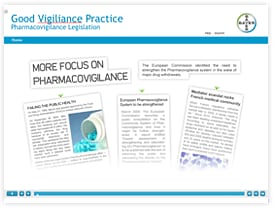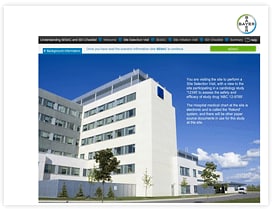About e-learning
What is e-learning?
At Bayer, we define e-learning as:
“Instruction delivered on a digital device to support learning”
(Clark, 2011)
There are two types of e-learning that are commonly used within Bayer:
- Asynchronous e-learning: a flexible and self-paced approach to learning that relies on the learner starting and completing their learning in their own time and around their work priorities.
- Synchronous e-learning: a structured and real-time approach to learning that relies on learners being present and available to attend sessions at scheduled times, albeit virtually.
Important note: This Digital Guide to e-Learning focuses primarily on the design and development of asynchronous e-learning modules often referred to as web-based training (WBT). For alternative asynchronous e-learning scenarios, please see the chapter on Other Asynchronous e-Learning Scenarios.
How do we classify e-learning modules?
In order to meet the expectations of our business priorities, timescales and budgets, we adopt classifications of asynchronous e-learning modules, which is also connected with our learning outcomes levels (Bloom, 1956):
Below, you will find an overview of the functionality in different classifications as well as a visual showing how effort and features correlate.


Recorded Presentations: Very quick and easy to produce. You can use the Video@Bayer system and the integrated Qumu screen recorder to easily record a PowerPoint presentation including a voiceover. This recording can quickly be uploaded and distributed using the Video@Bayer system.

Rapid: Quick and easy to produce, but this approach is very limited in terms of learning outcome levels and business benefits achieved. The only proviso is that content acquisition is already in place and agreed upon by subject matter experts within Bayer. This content may well be provided to e-learning companies in a PowerPoint or Word format. In order to stick to the ‘rapid’ approach, the module is then authored using existing templates. Production time is spent either on converting PowerPoint into an e-learning program or on repurposing existing design and content to create more professional designs (e.g. Figure 1). Despite the fast turnaround times for these types of modules, the learning outcome level is basically information exchange. This means that the business benefit is one of awareness, primarily for compliance purposes, i.e. to demonstrate that Bayer has provided relevant information to the learner.

Custom / Standard: Reasonably quick and easy to produce, but this approach only offers limited learning outcome levels and moderate business benefits achieved. There is some degree of flexibility with respect to the content acquisition of this category within our e-learning classification. Most content will already be available but may require further analysis in cooperation with the e-learning company in order to come to a common agreement on the final content in cooperation with subject matter experts within Bayer. This content may well be provided in the form of a PowerPoint or Word file but will evolve into a storyboard over the course of the design phase. In order to stick to the reasonably quick production approach, the module may well be authored using existing templates. Production time is spent on repurposing existing design and content to create more professional designs, but also potentially on developing a few interactive elements and adding audio narration to provide a more personalized learning experience (e.g. Figure 2). Although the turnaround of these types of modules is reasonably quick, the learning outcome level can be a mixture of information exchange and recall. This means that on the information exchange level, the business benefit is one of awareness, primarily for compliance purposes, i.e. to demonstrate that Bayer has provided relevant information to the learner. At the same time, as a result of the recall or understanding level, the module may also include assessments to test that the learning did actually occur and that learners are able to achieve the intended outcome.

Bespoke / High Level: Time-consuming and complex to produce, but this approach offers high levels of learning outcome and business benefits achieved. Some basic content will be available, but will require further analysis with the e-learning company in order to come to a common agreement on the final content in cooperation with subject matter experts within Bayer. This content may initially manifest as a PowerPoint or Word file, but will evolve into a storyboard over the course of the design phase. As this will necessitate a new and sophisticated design approach, the module will not be authored using templates. Production time will be spent on designing a new concept with multiple interactive elements, including audio narration as standard (e.g. Figure 3). Although these types of modules take a considerable amount of time to design and develop, there are demonstrable benefits for the business, especially regarding high-priority initiatives. The learning outcome level will be higher at the application and evaluate / analyze levels. This means that application level learners must be able to demonstrate that they can achieve the outcome; e.g. the learner is asked to complete a simulation of a specific system functionality, or is asked to undertake a simulation to categorize particular documents or tasks. Whereas, for the evaluate / analyze level, this can be done by means of assessment such as asking the learner to complete a simulation to spot errors in a document / deliverable or to undertake a branched decision-making scenario to reach the correct business decision.
When to choose e-learning
Before you consider e-learning as a method for delivering training, you should first go through a training analysis phase. The outcomes of the analysis, specifically defining the target audience and the learning outcome statements, will support you in deciding whether e-learning is the right training delivery method for your purposes. Here you will find some general recommendations to determine when e-learning is beneficial and when it should be avoided:
E-learning can be beneficial if:
- A large number of participants are to be trained within a short timeframe.
- The learning objectives are on an knowledge level (info exchange or recall / understand level).
- You want to raise awareness about particular topics.
- The target audience is widely spread out or in-person trainings are difficult to set up.
- The topics are static and the e-learning does not need to be updated frequently.
- Documentation of knowledge checks / assessments is necessary.
- The learning objectives can be achieved in an appropriate timeframe via e-learning.
- There is a high fluctuation in roles and persons responsible within a given business area where classroom training is not appropriate as a result of budget and time resources.
You should be cautious about using e-learning if:
- You want to change the behavior of the participants.
- You have a small target audience.
- If you want personal or intimate discussions.
You should integrate e-learning with other formats, such as classrooms or communities, if:
- You plan to reduce classroom time, but still want to be able to increase skill levels and/or change behaviors.
- You want to give participants the opportunity to ask questions and get feedback.
- You want to initiate networking and to use social learning.
- The main learning objectives can only be achieved through the sharing of best practices.
- You want to further improve the effectiveness and sustainability of the learning program.





